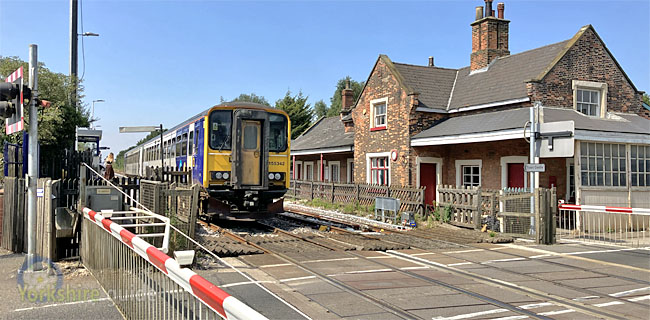Howden
East Riding of Yorkshire
A dominant feature of the town is the partially ruined Howden Minster. The ruins of a 14th century chancel and chapter house are now preserved by English Heritage. They adjoin St Peter's Church, a cathedral-like minster which is still in use as the parish church.
After the Norman invasion of 1066, an earlier Anglo-Saxon church and the land around Howden was granted by William the Conqueror to Durham Priory.
Howden itself also began to decline in importance as Goole around 3 miles across the River Ouse to the south became an important port to the expanding industry of the West Riding of Yorkshire.
The Shire Hall, built as a covered market and assembly rooms, has a Dutch-style stepped gable and mullioned windows. Its uses have also included a theatre and roller-skating rink and it continues in use today as a multi-functional community building which hosts local events as well as touring theatre and cinema shows.
In 1916, a site about two miles north of Howden became used as an airship station by the Royal Naval Air Service and later the Royal Air Force. In 1924, the site was bought by the Vickers company for the manufacture of its R100 airship, designed by Sir Barnes Wallis. The site continued in use until 1929, when airship manufacture was moved to Cardington in Bedfordshire. Chief engineer at Howden was Nevil Shute Norway, who later publshed novels as Nevil Shute.
 Town features
Town features
 The town is near to the River Ouse.
The town is near to the River Ouse. Howden has a historic minster.
Howden has a historic minster.
 Howden has local traders and a supermarket. Howden offers bakery goods, butchers, clothes, crafts, gifts and other goods.
Howden has local traders and a supermarket. Howden offers bakery goods, butchers, clothes, crafts, gifts and other goods. The town has a Post Office.
The town has a Post Office. The town has a pharmacy.
The town has a pharmacy.
 Howden has a choice of pubs.
Howden has a choice of pubs.  Bistro and cafe dining can be found in Howden.
Bistro and cafe dining can be found in Howden.
 Takeaway food outlets in the town include fish and chips, chinese, curries, pizzas, sandwiches.
Takeaway food outlets in the town include fish and chips, chinese, curries, pizzas, sandwiches.
 Howden has a museum - Howden Heritage Centre.
Howden has a museum - Howden Heritage Centre. The town has a library with limited opening times.
The town has a library with limited opening times.  Howden has a community centre.
Howden has a community centre.  The town has a cinema.
The town has a cinema.  Howden has a theatre.
Howden has a theatre.  There are public toilets in the town.
There are public toilets in the town.  Places of worship: Anglican, Catholic, Methodist.
Places of worship: Anglican, Catholic, Methodist. Travel
Travel
 Howden station
Howden station
 Station managed by: NORTHERN. Operator/s: HULL TRAINS, NORTHERN.
Station managed by: NORTHERN. Operator/s: HULL TRAINS, NORTHERN.  NATIONAL RAIL - Departure and station info
NATIONAL RAIL - Departure and station infoExternal link to National Rail live departure board for services at this station (opens in new tab).
Station is 1 mile north of town centre.
 Bus travel
Bus travel
The town has buses to neighbouring towns and villages.  Road travel
Road travel
Howden can be reached via the M62 A63 A614 B1228 B1230  Places to visit
Places to visit
 Selby Abbey
Selby Abbey
The Crescent, SelbyMore information at
 Selby Abbey
Selby Abbey Emergency services
Emergency services
Humberside Police  Humberside Police
Humberside PoliceHumberside Fire and Rescue Service
 Humberside Fire and Rescue Service
Humberside Fire and Rescue ServiceYorkshire Ambulance Service NHS Trust
 Yorkshire Ambulance Service NHS Trust
Yorkshire Ambulance Service NHS Trust Local government
Local government
Civil parish council
Howden Town CouncilProvides some local services in the area.
Link to council website:
 Howden Town Council
Howden Town CouncilUnitary authority
The East Riding of Yorkshire Council is now a unitary district rather than a county authority but the least changed of any of the historic Ridings of Yorkshire.
It does now cover a small part of the former West Riding, while it has lost portions of the historic East Riding to North Yorkshire and York.
Other towns in the East Riding include
The authority covers a near full range of council services, except the limited services handled by the various civil parish/town councils which exist throughout its area.
The 26 wards in the authority each elect one, two or three councillors to make up a 67 member council. An election for the entire council is held every four years with the most recent election in 2019.
Link to  East Riding of Yorkshire Council
East Riding of Yorkshire Council
 East Riding of Yorkshire Council
East Riding of Yorkshire CouncilPolitical composition after May 2023 election:
67 members
County strategic authority
Hull and East Yorkshire Combined AuthorityLaunched in 2025, the mayoral combined authority covers combined services including public transport and decisions about house-building and economic development across
 Hull
Hull East Riding
East RidingElected mayor: ❚ Luke Campbell
 Hull and East Yorkshire Combined Authority
Hull and East Yorkshire Combined AuthorityPolice and Crime Commissioner
The Police and Crime Commissioner for HumbersideOversees Humberside Police covering an area made up of the unitary authority councils of East Riding of Yorkshire, City of Hull and, south of The Humber, North Lincolnshire and North East Lincolnshire.
Elected P&CC:
 Police and Crime Commissioner for Humberside
Police and Crime Commissioner for HumbersideFire Authority
Humberside Fire AuthorityThe fire authority is made up of elected members of each of the four unitary authorities served by the Humberside Fire and Rescue Service - East Riding of Yorkshire, Hull, North East Lincolnshire and North Lincolnshire.
 Humberside Fire Authority
Humberside Fire AuthorityParliamentary constituency
Goole and PocklingtonElected MP:
National government region
Yorkshire and the HumberCeremonial county
East Riding of YorkshireHistoric
1889-1974 West Riding of Yorkshire (county authority)1974-1996 Part of a borough within the artificially-created county of Humberside